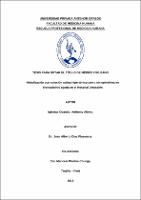Mostrar el registro sencillo del ítem
Nebulización con solución salina hipertónica con o sin epinefrina en bronquiolitis aguda en el Hospital Jerusalén
| dc.contributor.advisor | Diaz Plasencia, Juan Alberto | |
| dc.contributor.author | Iglesias Obando, Anthony Alexis | |
| dc.creator | Iglesias Obando, Anthony Alexis | |
| dc.date.accessioned | 2018-09-06T15:58:20Z | |
| dc.date.available | 2018-09-06T15:58:20Z | |
| dc.date.issued | 2018 | |
| dc.identifier.uri | https://hdl.handle.net/20.500.12759/4271 | |
| dc.description.abstract | OBJETIVO: Identificar el tratamiento con mayor efectividad para el manejo de bronquiolitis aguda en pacientes que acuden al servicio de emergencia de un hospital público considerando los tratamientos con solución salina hipertónica (SSH 3%) con y sin epinefrina. MATERIAL Y MÉTODO: Se utilizó un estudio prospectivo en una muestra de 30 pacientes menores de 2 años con bronquiolitis aguda, distribuidos en 2 grupos. El primero para tratamiento con SSH 3% + epinefrina, y el segundo para tratamiento con SSH 3% sin epinefrina, lo cual constituye la variable independiente. La efectividad se analizó en las variables dependientes: Saturación de oxígeno (Sat.O2), Frecuencia cardiaca (FC) y Score de Bierman y Pierson. Se utilizó la prueba T de Student para muestras independientes y para muestras relacionadas con su prueba de significancia estadística (p<.05) y estadístico de asociación chi-cuadrado con su prueba de significancia estadística (p<.05). RESULTADOS: En ambos grupos de estudio se evidencia una mejoría en el nivel de saturación de oxígeno (M Post =97.93). En el grupo con epinefrina se observa una variación significativa de la frecuencia cardiaca (M Post =119.00), lo cual no sucede en el grupo de SSH 3% (M Post =71.67) con p <0.5. CONCLUSIONES: Ambos tratamientos son efectivos para el tratamiento de bronquiolitis aguda, con la diferencia en cuanto a efectos colaterales por lo cual la SSH 3% sin epinefrina es el tratamiento recomendado, dejando a la epinefrina para los casos de no respuesta a la SSH 3% sola o casos estacionarios. | es_PE |
| dc.description.abstract | OBJECTIVE: To identify the treatment with greater effectiveness for the management of acute bronchiolitis in patients who attend the emergency room of a public hospital, considering the treatments with hypertonic saline solution (HSS 3%) with and without epinephrine.. MATERIAL AND METHOD: A prospective study was used in 30 patients younger than 2 years with acute bronchiolitis, divided into 2 groups. One group with HSS 3% and epinephrine, and the other group with HSS 3% and without epinephrine. The dependent variables were: oxygen saturation (Sat.O2), heart rate (HR) and the Bierman and Pierson Score. The T student test was used for independent samples and chi-square test for association, both with stadistical significance (p <.05). RESULTS: In both groups there is an improvement in the oxygen saturation (Mpost = 97.93). In the group with epinephrine a significant variation of heart rate is observed (MPost = 119.00), which does not happen in the group of HSS 3% (Mpost = 71.67) with p <0.5. CONCLUSIONS: Both treatments are effective for the management of acute bronchiolitis. But there is a difference in the presence of side effects, for which HSS 3% without epinephrine is the recommended treatment, leaving epinephrine for cases of non-response to HSS 3% or for stationary cases. | en_US |
| dc.description.uri | Tesis | es_PE |
| dc.format | application/pdf | es_PE |
| dc.language.iso | spa | es_PE |
| dc.publisher | Universidad Privada Antenor Orrego - UPAO | es_PE |
| dc.relation.ispartofseries | T_MED.HUMA_2401 | |
| dc.rights | info:eu-repo/semantics/openAccess | es_PE |
| dc.source | Universidad Privada Antenor Orrego | es_PE |
| dc.source | Repositorio Institucional - UPAO | es_PE |
| dc.subject | Tratamiento con epinefrina | es_PE |
| dc.subject | Tratamiento sin epinefrina | es_PE |
| dc.title | Nebulización con solución salina hipertónica con o sin epinefrina en bronquiolitis aguda en el Hospital Jerusalén | es_PE |
| dc.type | info:eu-repo/semantics/bachelorThesis | es_PE |
| thesis.degree.level | Título Profesional | es_PE |
| thesis.degree.grantor | Universidad Privada Antenor Orrego. Facultad de Medicina Humana | es_PE |
| thesis.degree.name | Médico Cirujano | es_PE |
| thesis.degree.discipline | Medicina Humana | es_PE |
Ficheros en el ítem
Este ítem aparece en la(s) siguiente(s) colección(es)
-
Medicina Humana [2717]

